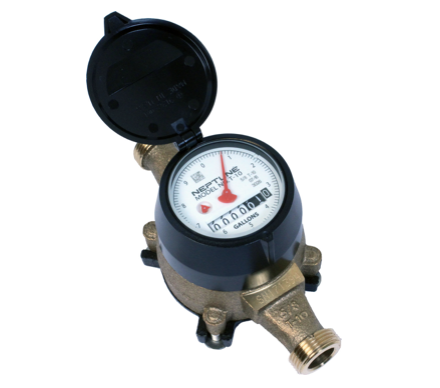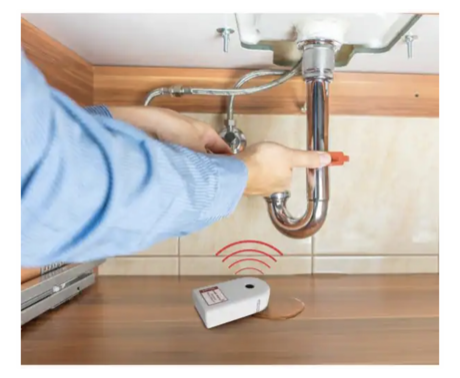
In our homes we rely on water in so many ways, such as baths and showers, dishwashers, washing machines, watering our lawns and plants, and more. Putting it simply, water is your friend. Until it isn’t!
When water sneaks out of where it should be, it can very quickly become your enemy, wreaking costly damage to your floors, foundation, and furnishings. Can it happen to you? It sure can! A majority of homes will spring a water leak. Some will be minor, but others can be devastating to both your home and your wallet. The worst part? Not all water leaks are obvious. You may not know about a leak until it has done serious damage. That’s why it’s crucial for you, the homeowner, to learn how to find water leaks before they do much damage. Here are some tips and tricks for finding leaks.
Check your bill

Photo by Neptune Water Meters.
If you are on a municipal water system, you receive a monthly water bill.
Generally, there’s not much variation in your water bill. However, if you are watering your lawn and garden a lot in the summer, your bill may increase by as much as 40%.
The average family of four uses no more than 12,000 gallons a month, according to the EPA. If you’re using much higher amounts, you probably have a leak somewhere. You’d be surprised how quickly it all adds up. A leaky faucet with a steady drip can waste nearly 10,000 gallons a year! That’s the equivalent of washing 300 loads of laundry, and it can add up to 30% to your water bill.
If you are on a well, you won’t be getting a water bill, but that doesn’t mean you’re not wasting hard-earned cash. Your well pump is using electricity to pull that water up from the ground, and a steady leak can raise your power bill. Leaky faucets, shower heads, and hoses can increase the demand on your well pump as much as two to three gallons per minute. That can increase pump demand by more than 4,000 gallons over a 24-hour period. That means your electric bill is racking up all that extra demand.
Become a do-it-yourself water meter reader
Again, this only works if your home is connected to a municipal water supply. In colder climates, the water meter may be located underneath a small, manhole-style cover near the street. In warmer areas it may be located on the side or back of your home where the water supply enters. Here’s the recipe for using the meter to check for leaks:
- Turn off all faucets in your home, and be sure the dishwasher and washing machine are not in use.
- Check the water meter and write down the numbers.
- Wait one hour.
- Check the meter again. If the numbers have gotten higher, there’s a leak somewhere in your system.
- Now you must determine if the leak is inside or outside your home. Find the main shutoff valve in your home. This may be in a basement or utility room where the main water supply pipe enters your home. Turn off the shutoff valve, and then check a few faucets to be sure the water has stopped.
- Now check the water meter again, and write down the numbers.
- Wait another hour.
- Check the meter again. If the numbers haven’t changed, the leak is somewhere inside your home. If the numbers have changed the leak is in the water line that runs underground to your house. Call your water company and report the situation.
The green, green grass of home

Is there an area on your lawn where the grass is greener and grows faster than the rest of your yard? You might have a leaking water line underneath that area. If that part of the yard is always wet and squishy, you can be sure there’s a leaky pipe under there. If you’re not comfortable dealing with it yourself, call in a professional.
Take a look under the hood
If your meter test indicated a leak, or if your electric bill seems to be creeping up, it’s time to check the obvious places where leaks can spring. Look in the cabinets under all your sinks, and make sure they are dry. Next, check around tubs, showers, and toilet for signs of leaks, and then check below your water heater, washing machine, and dishwasher for small puddles or water stains. If you find puddles, shut off the water supply to the appliance and call in a plumber.
Time to dye!
If you hear trickling noises from your toilet tank, it probably means flapper has become brittle, and water is leaking into the bowl. This can waste upward of 200 gallons of water a day, and raise you water bill a few hundred dollars within a year.
Don’t hear anything? The leak may be too small for your ears to detect. Here’s how to tell if your flapper has a trickle. Get a bottle of red food coloring and put a few drops into the tank of all your toilets. Wait five minutes. If you see red in the bowl, it’s time to replace your flapper. This is an easy, do-it-yourself job. Or call a plumber if you’re not comfortable tinkering around in your toilet tank.
Click here to see a Home Depot video on toilet flapper replacement.
Become a leak detective
Some leaks are obvious, such as finding water leaking underneath your kitchen sink. Unfortunately, many can be stealth leaks, which might go unnoticed until they cause serious damage to your home.
Here are some things to notice:
- A dripping noise. If you hear a dripping sound inside walls, that’s a strong indicator that you have a problem. However, some leaks are silent but deadly, such as water oozing down along a wall stud.
- Wall or baseboard discoloration. Water might be leaking behind the drywall and soaking through, or it could be collecting at the bottom of baseboards.
- Bubbling paint or wallpaper. If the wall board is wet, paint or wallpaper my have trouble adhering to the wall. If this is accompanied by a bulge in the wall, chances are this has been going on for a long time. The damage is more extensive and that section of wall board will need to be removed and replaced after the leak is fixed.
- Musty odors. An unchecked leak is an ideal breeding ground for mold. Sometimes you may see black blotches on your side of the wall, but many times the mold is growing out of sight behind the wall. Don’t ignore musty odors. They are a warning sign of what could be a serious and costly problem.
This may be alarming!

When it comes to leaks, early detection is your best insurance policy. Some areas are just “leak magnets.” You can install Zircon Electronic Leak Detectors in those areas.
Put them in cabinets under sinks, near your water heater, and close to water pipes that lead to exterior faucets that might burst during cold winter months. A shrill alarm will alert you to the slightest amount of water, giving you time to shut off the water supply and make repairs before serious damage occurs to your home.
In conclusion, always take water leaks seriously, and stop them before they do serious damage to your home.
Buying or selling a home in or near Asheville?
Avoid unpleasant surprises! Contact Asheville Home Inspector Peter Young before signing any contracts. Call (828) 808-4980, or click here to make an appointment online.